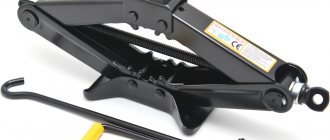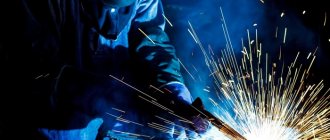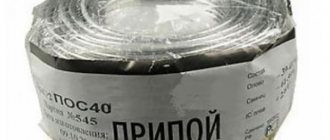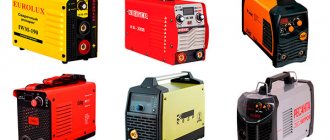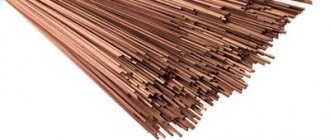Coating metal surfaces with zinc is a popular, cost-effective way to protect against oxidative damage. As a result, a zinc layer with a strong oxide film is formed on the outside.
Zinc oxides, unlike similar iron compounds, have a dense structure with a minimum number of tiny pores. Moisture and oxygen from the environment cannot penetrate the microcells and cause damage. But welding galvanized steel without special knowledge and skills presents a certain difficulty.
Features of the material
There are several galvanizing technologies, with different thicknesses of protective coating. The thickness of the formed layer varies in the range from 2 μm to a maximum value of 150 μm.
When welding any galvanized product, for example a sheet, the metal is heated to a temperature exceeding 1000 °C. The process is accompanied by negative phenomena:
- zinc passes first into the liquid phase, then into the gaseous state. Its melting point is 906 °C;
- vapors penetrate not only into the air, but also into the base, disrupting the structure of the base metal;
- Evaporation particles disturb the quality of the galvanized seam.
The biggest danger is the toxicity of the fumes. Galvanizing during welding is harmful to health. The work site must have strong ventilation of the welding area and effective general ventilation of the room.
Welding with inverter
Inverter welding is usually used for thin metals. During the welding process, current with reverse polarity is used. The terminal with a negative charge is connected to the metal being welded, and the one with a positive charge is connected to the electrode holder.
Inverter welding of galvanized steel occurs with minimal deformation and burning of the metal structure. The reverse polarity of the current ensures strong heating of the electrode, which is what allows welding to be performed directly across the connection. The result is a durable seam without cracks, pores and defects.
So how to cook galvanizing using an inverter with an electrode? Let's look at the main features:
- to obtain a high-quality seam, it is recommended to use thin electrodes with a diameter of no more than 2 mm;
- For welding, it is worth using products with an increased melting coefficient. This will allow welding of thin products at low current, which has a positive effect on the quality of the welded joint;
- welding of thin structures with an inverter should be performed with slow movements of the electrode;
- In order to avoid burning the product during the work and to ensure an even connection, it is necessary to position the electrode within 45-90 degrees to the surface to be welded.
Welding of galvanized metal products can be performed using different methods, which may have distinctive features. Before starting this process, you should carefully consider the important recommendations and rules for welding galvanized steel. It is also worth considering the characteristics of the material, which can complicate the welding process.
Removing the coating
There are several methods for welding galvanized steel. The choice depends on the quality of the metal, the thickness of the coating on it, and the prospects for using the structure.
The easiest way is to remove the surface layer of galvanization mechanically. Any hard abrasives are suitable for this. Galvanizing requires a lot of effort when cleaning.
You can remove the layer thermally, but when heated, harmful fumes are again possible. There are chemical ways to remove the coating in the area of future seams.
The concern is the remains of unprotected metal areas near the seam. Galvanization with such exposed areas may be subject to corrosion in the future, which will cause damage to the entire structure .
Shutdown
After welding work, it is necessary to ventilate the room and remove zinc shavings.
It should be borne in mind that the cleaned areas will be subject to corrosion and cause a decrease in the quality of the entire structure. Therefore, after completing work, it is necessary to remove scale from them, sand the seam and apply a protective coating.
The surface in the area of the weld must be coated with paint or an anti-corrosion coating. A good option would be paint containing 94% zinc dust. It is possible to fuse zinc wire or rods made of zinc-cadmium alloy.
Selection of electrodes
If it is technically impossible to remove the outer layer, you can use another approach, acceptable for coatings with a thickness of no more than 15 microns.
Welding of galvanized steel with low carbon content can be performed with rutile-coated electrodes (ANO-4, MR-3, OZS-4). The titanium oxide they contain simplifies the initial and repeated ignition of the arc, reduces losses due to the formation of spatter, and ensures the strength and tightness of the seam.
To weld low-alloy steels, you need electrodes with strong basic fluxes (UONI-13/45, UONI-13/55, DSK-50). To prevent the formation of pores, the welding current must be increased by 10 - 50 A.
The process should be carried out carefully, reducing the speed by 10 - 20% compared to conventional welding. Working with galvanized steel during welding requires special skills. You will have to approximately double the distance between the edges to be joined. By fulfilling all the requirements, you can get a good welding seam.
When the thickness of the coating layer is more than 15 microns, but less than 40 microns, another technology is effective. It is necessary to alternate forward movements with return movements with the electrode until the galvanization is clean.
It is important to focus on the required boundaries and not damage the layer in adjacent areas. This effective surface cleaning method produces a durable seam.
general information
So, as we already wrote above, galvanizing is the protection of metal from damage and corrosion. In this case, the zinc layer can vary from 1 to 20 micrometers. The larger the layer, the better the protection.
By the way, it is the anti-corrosion properties of zinc that are most powerful. Even if you scratch or dent the metal, corrosion is unlikely to form. For this reason, the metal is often galvanized in the production of cars and ships.
Galvanizing not only protects the metal from corrosion, but also has a number of other advantages. When working with galvanizing, the metal practically does not splash, which is very convenient, especially for beginners. Also, in the weld formation zone, additional cathodic protection of the metal is provided. In addition, the finished seam does not require labor-intensive processing.
Use of a semi-automatic device
A good result is obtained when welding galvanized steel using a semi-automatic machine with correctly selected additives. Practice has confirmed the effectiveness of additives containing copper in combination with silicon, aluminum or manganese. These can be the following substances: CuSi3, CuAl8, CuSi2Mn. The strength of the connection and the ease of subsequent machining depend on the ratio of the components.
The combination of copper and silicon, which galvanization contains, contributes to the formation of a not very strong, but easily processed seam.
Inorganic copper-aluminum composite is primarily recommended for products containing aluminum in weldable structures.
A three-component substance of copper, silicon and manganese provides a weld with increased strength. Subsequently, considerable effort must be made to process it.
Copper melts at a temperature lower than the melting point of steel alloys. Therefore, such welding of galvanized steel is very similar to soldering.
The wire, like an additive, must be fed into the working area smoothly and accurately into the tip that ensures contact. For feeding, it is better to use a drive with 4 rollers, and carefully select the tip according to size.
If everything is done professionally and correctly, then both the base metal and the seam are protected from corrosion with minimal initial energy consumption for welding.
The work area is cleaned strictly within the designated dimensions. There is no spattering of materials when heated to welding temperature. In this case, galvanization is welded firmly.
To ensure process stability, the power source and adjustment modes are carefully selected. The maximum quality of a galvanized weld is achieved with a pulsed current in an inert argon environment. Helium, carbon dioxide or other inert gaseous substances can also be used as protective gases.
Useful tips
Experts are advised to pay special attention to some points:
- After cleaning the joint with a steel brush, restoration of the zinc coating with special protective compounds is required. They come in aerosol packages and small containers. They are used to process the seam and the connection point of the terminal (crocodile clip).
- At the joints, the current is increased to 15 amperes, and the speed of the electrode is reduced; a dense bead should be formed that can withstand the dynamic bending load.
- A short arc allows you to control the quality of the seam, and there is less spattering of the bathtub metal. The likelihood of sparks burning through the zinc coating is reduced.
- The equipment is configured for low-current modes. On semi-automatic devices the “Synergic” mode is set, on inverters – 5-10 amperes below the table values.
- Beginners should not forget to check the quality of the seam. After removing the slag, it is visually inspected and gently tapped, this makes it easier to identify the defect.
Point method
Galvanization with Al, Mn, Si additives (so-called TRIP steels) is widely used in the automotive industry. Materials can be successfully welded when resistance spot welding is performed correctly.
When carrying out serial operations, in accordance with reference indicators, the shape and dimensions of the electrodes are selected, taking into account the thickness of the galvanized material.
The resulting connection point is characterized by strength, which is higher than that of the original sheets. When checking a seam for rupture, the rupture line does not pass through the welding point, but nearby.
Inverter-type welding machines operate on direct or alternating current. A method that provides good results requires a lot of energy.
Contact equipment that supplies three types of pulses is popular: for preheating the working area, directly welding galvanized steel, and subsequent heat treatment.
When spot welding any materials, including galvanized steel, the electrodes noticeably wear out. Therefore, at stationary welding stations there is an automatic possibility of adjusting modes and adjusting the process as a whole.
It is almost impossible to do this using manual technology. During one cycle, changing the size and shape of the seam is unacceptable. Spot welding in industrial flows is carried out using modern, fully automated equipment.
Methods of welding galvanized metal
Gas and electric arc welding can be used to connect galvanized sheets. Point detection is possible; this method is applicable in enterprises. For spot welding of galvanized steel, special machines are needed. In a garage, galvanized arc welding is more often used using protective fluxes, special electrodes or wire, less often semi-automatic, it is used in auto repair shops, in production, and requires expensive equipment. Each method of welding galvanized metal structures has its own advantages. Getting to know the advantages and disadvantages of each will help you decide on the choice of device. How and how to weld galvanize depends on the experience of the welder. Using traditional galvanizing welders requires skill. Beginners will find it difficult to maintain the amperage. It is difficult to avoid lack of penetration or burns. An inverter or semi-automatic is preferable in this regard.
How to weld pipes
The approaches to installation and repair of pipelines made of metal alloys with zinc coating are the same as when working with other products.
Fluxes can be used. First, the pipes to be welded must be thoroughly cleaned outside and inside, then heated. If the diameter does not exceed 3 mm, the edges do not need to be specially processed.
For pipes with a large diameter, the edges are opened by 90 degrees and blunted by 1.5 mm. The gap width during welding in both cases is 2-3 mm. Softened flux is applied to the galvanized surface in double the amount used for uncoated steel pipes.
If the pipe diameter does not exceed 250 mm and the metal thickness is 6 mm, choose nozzles with a size of up to 2 mm. To weld wider pipes made of thick metal, nozzles with sizes from 2 mm to 4 mm are needed.
Good quality at high speed of execution is ensured by electric arc welding of any zinc-coated pipes. A highly qualified welder, the correct choice of electrodes, and optimal process speed will ensure the quality of the galvanized connection. To prevent oxidation processes after work is completed, the welding site and adjacent areas must be treated with special compounds.
Preparation
Welding galvanized steel is a job that can be done even by amateur welders. Before carrying out work, it is recommended to practice on some similar scraps in order to “get your hands on” and adjust the settings of the device.
The welder must observe a number of personal safety measures:
- work must be done in a regular protective mask and respirator, or in a mask with a ventilation device;
- Insulated gloves must have a rubber coating.
Galvanization welding is carried out using any of the main joining methods:
- Manual welding – for steel with a thickness of 1.5 mm.
- Welding with a semi-automatic machine - used for metal more than 0.6 mm thick.
- Resistance spot welding – intended primarily for joining sheet metal up to 0.45 mm thick.
- Gas welding with an oxygen-acetylene mixture – suitable for steel of any thickness.
Regardless of the welding method chosen, a number of conditions must be taken into account:
- The melting point of zinc (420°C) is lower than the melting point of steel (1100-1200°C), and evaporation occurs already at a temperature of 906°C. Zinc vapor in the air pollutes the atmosphere and has a harmful effect on the health of the welder.
- The zinc melt foams and enters the steel structure, violating the specified parameters of the metal, and zinc flowing into the weld leads to a loss of its quality.
- The seam is made “in flow”, the electrode or torch is applied repeatedly, with short touches.
- You should not weld large areas with one seam; you should control the quality of the weld.
- Before welding, the zinc must burn out completely to avoid foaming of the seam.
- When the steel thickness is more than 4 mm, a chamfer is made in the welded joint to 1/3 of the sheet thickness.
- To prevent the zinc from burning out, you can put an asbestos cloth on the metal, or just a wet cloth.
Other methods of joining galvanized products
Another way to connect galvanized pipes without heating them is threaded joining. Cutting threads on galvanized pipes is quite difficult, so this method is practiced mainly on products with a small cross-section. In addition, this method is financially more expensive compared to conventional welding. Another important point is that in the thread cutting area the zinc layer will be destroyed, so the pipe will begin to rust faster.
To assemble water supply and heating communications, non-welded sets of pipes with fittings, reminiscent of a construction set, can be used. This kit contains a special coupling with a sealing ring, which is secured with bolts to the groove along the edges of the pipe. Although this method of pipe assembly is not yet widespread in our country, it provides a strong connection and is performed very quickly.
To summarize, we can say that the answer to the question of whether it is possible to weld galvanized pipes will be positive, provided that safety precautions and work technology are followed, as well as experience. Remember that it is very important to avoid overheating of the pipes and evaporation of zinc. These phenomena can be prevented using flux and rutile electrodes. Alternative methods of joining pipes, although they have a right to life, however, are significantly more expensive.
Source
Connecting zinc-coated pipes using manual electric arc welding
To prevent porosity in butt and fillet welds, you can increase the current and reduce the welding speed. To do this, you will need electrodes for galvanized pipes, which are selected depending on the grade of steel. In particular, the brand of electrodes for welding galvanized high-carbon steel pipes is selected with a rutile coating. And if low-alloy steel is used for pipes, then electrodes with a basic coating are quite suitable.
Electrodes with rutile coating have a whole list of advantages:
- Due to the presence of titanium oxide in the electrode, the arc can be ignited very easily and quickly, and repeatedly.
- Welds with such an arc are sealed, durable and of very high quality, without any defects.
- There is virtually no splashing during operation, so material losses are negligible.
The rutile coating of the electrode may contain inclusions of iron powder. It helps reduce the specific gravity of carbon in the zinc layer and increases resistance to cracking.
It is worth noting that to perform welding work using electric welding, you need at least minimal practical experience (for more details: “How to weld pipes using electric welding correctly - a step-by-step guide”). In addition to the outer coating of the electrode, its thickness also affects the arc power. In particular, an electrode that is too thick will produce an arc that will quickly burn through the material. On the contrary, it is unlikely that it will be possible to make a sufficiently powerful and high-quality seam with an electrode that is too thin. Since work is most often carried out with pipes with a wall thickness of 1.5-5 mm, the optimal electrode diameter will be 2-3 mm.
The speed at which the electrode passes over the surface also plays an important role in the welding process. If you do this too slowly, there is a high chance of burning the pipe. And if the speed of movement of the electrode is higher than necessary, the weld will be weak. The optimal speed can only be determined experimentally.
Do not forget to treat the seams with an anti-corrosion compound upon completion of welding work.
The anti-corrosion agent must meet the following parameters:
- have good adhesion to the surface;
- provide protection against oxidation on zinc coating;
- be convenient and easy to apply without special tools.
A good option for protecting galvanized products is a special paint containing about 94% zinc dust. This composition is easy to apply and holds well on a vertical surface due to the presence of unsaponifiable binders in it.
An alternative method of anti-corrosion surface protection is surfacing wire containing 99.99% zinc or zinc-cadmium rods.
HOW TO COOK GALVANIZED CORRECTLY: RULES AND TIPS
Galvanized steel is in constant demand and has gained popularity in many consumer areas.
The material has gained such popularity due to its resistance to aggressive external influences. Galvanized steel is highly resistant to corrosion and can last for quite a long time. This is achieved by applying a zinc layer with a thickness of 2 to 150 microns to steel sheets. However, zinc coating not only protects steel products from adverse influences, but also a factor that significantly complicates the metal processing process, in particular its welding. In order to answer the question: how to cook galvanizing , it is necessary to consider in more detail all aspects associated with this process.


